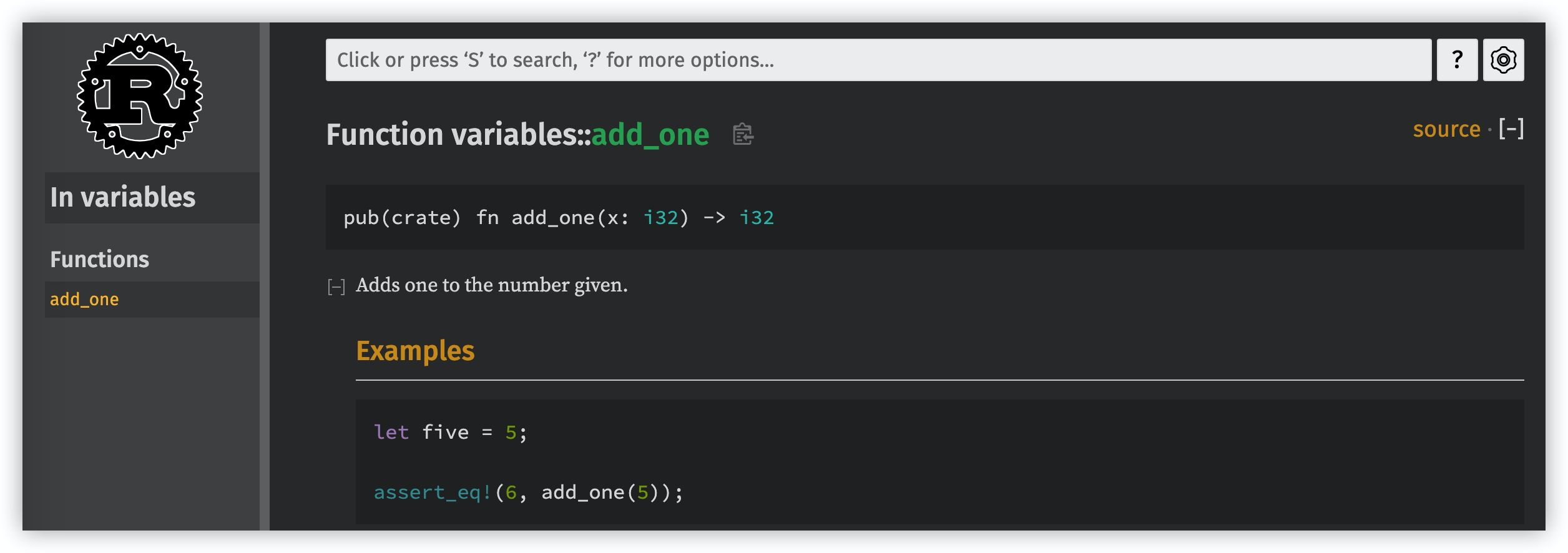Rust入门基础到进阶教程
2023年03月22日更新
152 人订阅
专栏简介
基础篇-安装Rust
基础篇-Hello, World!
基础篇-Cargo项目管理器
基础篇-编辑器vscode
基础篇-变量
基础篇-数据类型
基础篇-函数
基础篇-注释
基础篇-控制流
基础篇-所有权
基础篇-引用与借用
基础篇-Slice(切片)
基础篇-结构体
基础篇-方法
基础篇-枚举类型与匹配
基础篇-Option
基础篇-Vector
基础篇-String类型
基础篇-HashMap类型
基础篇-错误处理
基础篇-包、Crate和模块
基础篇-测试
进阶篇-泛型数据类型
进阶篇-Trait(特性)
进阶篇-生命周期
进阶篇-闭包
进阶篇-迭代器
进阶篇-进一步认识 Cargo 和 Crates.io
进阶篇-Cargo 工作空间
进阶篇-智能指针
进阶篇-多线程
基础篇-注释
- 木头
- 发布于 2023-02-16 13:50
- 阅读 2886
行注释,文档注释,模块注释
Rust 代码文件中,通常我们可以看到 3 种注释。
- 行注释
- 文档注释
- 模块注释
行注释
// 后的,直到行尾,都属于注释,不会影响程序的行为。
// 创建一个绑定
let x = 5;
let y = 6; // 创建另一个绑定文档注释
文档注释使用 ///,一般用于函数或结构体(字段)的说明,置于要说明的对象上方。文档注释内部可使用markdown格式的标记语法,可用于rustdoc 工具的自动文档提取。
/// Adds one to the number given.
///
/// # Examples
///
/// ```
/// let five = 5;
///
/// assert_eq!(6, add_one(5));
/// # fn add_one(x: i32) -> i32 {
/// # x + 1
/// # }
/// ```
fn add_one(x: i32) -> i32 {
x + 1
}执行生成文档命令:
$ cargo doc --open
Documenting variables v0.1.0 (/projects/variables)
Finished dev [unoptimized + debuginfo] target(s) in 0.99s
projects/variables/target/doc/variables/index.html--open 生成文档并打开,如果不加--open文档会生成在target文件夹。

模块注释
模块注释使用 //!,用于说明本模块的功能。一般置于模块文件的头部。
//! # The Rust Standard Library
//!
//! The Rust Standard Library provides the essential runtime
//! functionality for building portable Rust software.相对于 ///, //! 用来注释包含它的项(也就是说,crate,模块或者函数),而不是位于它之后的项。
- 学分: 4
- 分类: Rust
- 标签:
点赞 0
收藏 0
分享
本文参与登链社区写作激励计划 ,好文好收益,欢迎正在阅读的你也加入。
0 条评论
请先 登录 后评论
